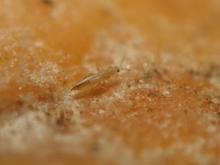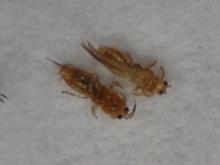Frankliniella occidentalis
Pest description and crop damage Adult thrips are yellowish brown to straw colored and about 0.04 to 0.08 inch in length. Nymphs resemble adults but are smaller and lack wings. Thrips feed on the fruit surface and often cause only cosmetic damage to developing fruit which appears as a surface stippling (microscopic, little white dots) or as a surface russet at harvest. Sometimes, the stippling may manifest itself on the fruit surface where multiple fruits or leaves contact each other. Nectarine is more susceptible than peach to thrips damage. Often thrips develop and overwinter on hosts outside the orchard; thus, their damage is heaviest in the perimeter rows.
Biology and life history The western flower thrips overwinter as adults in ground duff. Thrips usually emerge early, about popcorn stage. In the spring, they seek out flowers where they feed on pollen and nectar and lay eggs into floral parts. Larvae feed on surface tissues of flowers, buds, and leaves. When mature, the larvae drop to the ground and pupate. Adults that emerge may lay eggs on developing fruit. Under favorable conditions, a complete life cycle may be completed in two weeks. There are several overlapping generations per year. Seasonal migration occurs at various times of the year due to destruction or drying up of host plants, and adjacent crops may be invaded by these insects. Thrips eat pollen and nectar on a wide range of plants (at least 244 species from 62 families).
Pest monitoring In fruit trees with a history of thrips damage to fruit in previous seasons, thrips abundance during flower bloom can be monitored by destructively sampling flowers and searching for the adult and immature thrips. Yellow sticky traps can also be utilized to sample thrips. Scouting can be focused on perimeter fruit trees or in areas within the orchard with a history of thrips damage to fruit.
Management-chemical control
The best means of controlling thrips is by intercepting them as they move into the orchard or by applying products after petal fall to try to kill the thrips under the peach or nectarine shuck.
Management-chemical control: HOME USE
Petal fall spray
- acetamiprid-Toxic to bees.
- azadirachtin (neem oil)-Some formulations are OMRI-listed for organic use.
- gamma-cyhalothrin--Highly toxic to bees.
- horticultural mineral oil-Some formulations OMRI-listed for organic use.
- insecticidal soap-May require several applications. Complete coverage is essential. Not recommended for use on yellow-skin nectarine varieties. Some formulations are OMRI-listed for organic use.
- kaolin clay (Surround at Home)-Repels some insect pests when applied as a spray to leaves, stems, and fruit. OMRI-listed for organic use.
- lambda-cyhalothrin--Highly toxic to bees.
- plant-derived essential oils-Some have shown efficacy against thrips. Some formulations are OMRI-listed for organic use.
- pyrethrins-Highly toxic to bees. Some formulations are OMRI-listed for organic use.
- spinosad-Toxic to bees. Some formulations are OMRI-listed for organic use.
- zeta-cypermethrin--Highly toxic to bees.
Management-chemical control: COMMERCIAL USE
Petal fall spray
- spinetoram (Delegate WG) at 4.5 to 7 oz/A. REI 4 hr. PHI 1 day.
- spinosad (Entrust 80W) at 1.25 to 2.5 oz/A. REI 4 hr. PHI 1 day. Results are best when applied at petal fall. OMRI-listed for organic use. May act slowly.



